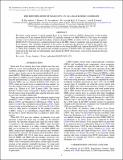THE IDENTIFICATION OF MAXI J1659-152 AS A BLACK HOLE CANDIDATE
Author(s)
Kalamkar, M.; Altamirano, D.; van der Klis, M.; Casella, P.; Homan, Jeroen; Linares Alegret, Manuel; ... Show more Show less
DownloadKalamkar-2011-The identification o.pdf (606.3Kb)
PUBLISHER_POLICY
Publisher Policy
Article is made available in accordance with the publisher's policy and may be subject to US copyright law. Please refer to the publisher's site for terms of use.
Terms of use
Metadata
Show full item recordAbstract
We report on the analysis of all 65 pointed Rossi X-ray Timing Explorer (RXTE) observations of the recently discovered soft X-ray transient MAXI J1659-152 (initially referred to as GRB 100925A). The source was studied in terms of its evolution through the hardness-intensity diagram (HID), as well as its X-ray variability properties. MAXI J1659-152 traced out a counterclockwise loop in the HID, which is commonly seen in transient low-mass X-ray binaries. The variability properties of the source, in particular the detection of type-B and type-C low-frequency quasi-periodic oscillations, and the way they evolve along the HID track, indicate that MAXI J1659-152 is a black hole candidate. The spectral and variability properties of MAXI J1659-152 imply that the source was observed in the hard and soft intermediate states during the RXTE observations, with several transitions between these two states.
Date issued
2011-03Department
MIT Kavli Institute for Astrophysics and Space ResearchJournal
The Astrophysical Journal. Letters
Publisher
IOP Publishing
Citation
Kalamkar, M., J. Homan, D. Altamirano, M. van der Klis, P. Casella, and M. Linares. “THE IDENTIFICATION OF MAXI J1659-152 AS A BLACK HOLE CANDIDATE.” The Astrophysical Journal 731, no. 1 (March 15, 2011): L2. © 2011 The American Astronomical Society
Version: Final published version
ISSN
2041-8205
2041-8213